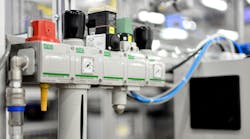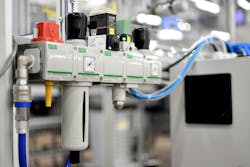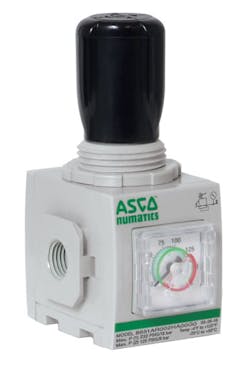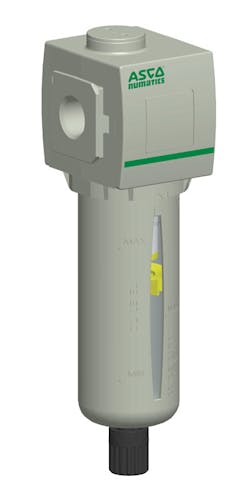The 6 Things Engineers Should Know About Pneumatic Filters, Regulators, and Lubricators
Filters, regulators, and lubricators (FRLs) are the unsung heroes of pneumatics. Although not as glamorous as the valves, manifolds, cylinders, and actuators that control machine motion, the FRLs play a critical role in production performance. In addition, shutoff and lockout valves are now part of FRL assemblies and add selection complexity. FRLs also play a key role in machine safety when adding safety valves for safe exhaust and protection against unexpected start-up. Choosing the correct devices and applying proper maintenance practices reduces upfront costs, extends FRL service life, and ensure equipment operates to specifications.
Furthermore, the latest trends in machine automation indicate that air preparation units are playing more visible roles as key IIoT components. More sophisticated FRLs measure critical variables such as flow, contamination, and pressure—using the information for further data analytics and decision making.
FRLs, such as this ASCO Numatics 651/652/653 Series air preparation manifold, are often the forgotten parts of a plant’s pneumatic system, but they have a big impact on machine efficiency and productivity.
FRL 101:The Basics
FRLs provide point-of-use control of air pressure and cleanliness in pneumatic networks. They are located upstream from the directional control valves, manifold, cylinders, and actuators. Virtually every pneumatic device requires some type of air preparation and pressure control.
Today’s FRLs use modular components that are placed in-line in one assembly. Typically, after the shutoff valve, the filter is the first component in the air line; then the regulator; and finally, the lubricator.
Filters are available in different varieties to let them remove oil, particulates, water, and odors from the compressed air. Particulate filters remove particles from the air stream and are available in pore sizes of 5, 25, and 40 microns. Coalescing filter pore sizes are smaller, ranging from 0.01 to 1.0 microns, to extract moisture and oil drops that can impact pneumatic performance. Adsorption filters, although rarely used, employ activated carbon to eliminate odors and residual oil vapor in the air.
Lubricators are installed to introduce small amounts of clean oil into the air stream. The oil cleans and protects downstream components from wear and corrosion.
Regulators set the incoming air pressure to the desired level for the cylinders and actuators operating machinery. Because pressure in the plant’s air drops frequently and varies, consistent pressure regulation is essential to ensure appropriate machine reaction times and speeds. The regulator is typically set slightly below minimum plant air supply pressure. Regulating to the correct pressure for the application also allows users to optimize energy consumption.
The ASCO Numatics 653 Series of air preparation products from Emerson lets users power more products from the same Filter-Regulator or Lubricator (FRL), or reduce pressure drop across the system, both of which can save energy and costs.
FRLs: Six Key Criteria
There are six key criteria engineers must consider to ensure they get the best FRLs needing the least maintenance:
The operating environment. The operating environment makes a big impact on which FRL is selected. It’s essential that the FRL’s components use appropriate materials and construction. First, will the assembly be located indoors or outdoors? If outdoors, consider the range of the operating temperature. Extreme hot or cold conditions requires components with high- or low-temperature ratings. Oil rig components and other exposed to the oceans must withstand saltwater corrosion. If indoors, caustic or chemical environments demand the FRLs use different types of seals or are mounted inside protective enclosures.
Proper pressure specification. Is your plant’s air-supply pressure a normal 125 psig or less? Or is it a high-pressure system? Most FRL components are designed to handle pressures up to 145 psig in standard sizes and configurations. However, some plant air supplies are rated at up to 250 psig. That means a high-pressure regulator and filter should be specified. Some new FRLs handle up to 300 psig.
Lubrication. Do your pneumatics require a lubricator? If you decide your machine’s pneumatic valves and cylinders require lubrication, a lubricator will be needed in the FRL assembly. The lubrication also acts like a detergent in the air system. As you continuously lubricate, the clean oil washes out contaminants that would cause the valves and cylinders to stick. If using this approach, a 5-micron particulate filter is usually sufficient.
If the pneumatics do not require lubrication, both particulate and coalescing filters are suggested. The coalescing filter helps remove the contaminants the lubricant would wash out.
Shutdown valves. Lockout valves are frequently required on a machine’s pneumatics. These components vent the air off equipment and are typically operated manually or electrically. When activated, these valves ensure no components downstream of the FRL will receive air. The objective is to exhaust air from the machine if there is a mechanical jam or if an operator enters the area.
Shutoff or isolation valves (low-flow exhaust) are installed on the upstream side of the FRL assembly while lockout valves (high-flow exhaust) are installed downstream.
Lockout valves come in quick-exhaust or soft-start quick-exhaust versions. With today’s modular architecture, it is easy to add shutoff, isolation, and/or lockout valves to the FRL assembly. Adding these devices is an application-specific decision and typically dictated by machinery components.
Correct air flow. The air flow rate is an important consideration in selecting FRL components. Engineers should ensure the FRL is properly sized to match the required machine air flow. Accurately calculating a machine’s air-flow requirements is complex and laborious for most equipment designers. Flow is determined by the air volume needed to fill and exhaust the pneumatic component and required response times.
For example, if a machine has a pneumatic cylinder with a 2-inch bore and 24-in. stroke, and you want to extend the cylinder through its entire stroke in 5 sec. at 60 psig, it requires a flow rate of about 2.5 scfm. However, if the same cylinder under the same conditions must travel through its stroke in 100 msec., the flow rate jumps from 2.5 to about 135 scfm. This does not include valve-to-cylinder tubing.
The FRL flow rate depends on the inlet pressure and pressure drop. Flow rate increase is directly proportional to increases to inlet pressure and/or pressure drop (known as ∆P). The FRL’s flow rate must be sized to peak demand, not average or mean demand.
Generally, equipment engineers size FRLs by matching their port size to the valve manifold’s or cylinder’s port size. Some simply rely on past experience. Accurately calculating the FRL’s air flow may take more time and effort but it will make the pneumatics more cost effective and efficient.
Most manufacturers offer FRL series with overlapping port sizes. Although each larger series offers significantly more nominal flow rates, changing port size within a series minimally alters flow capacity and can be more convenient for plumbing purposes.
Filter replacement. Our experience is that filter elements in a plant’s pneumatic system do not get replaced at the intervals required to maintain peak performance. This can lead to inefficient machine performance and possible downtime. Often equipment operators don’t know filter maintenance is required, so reliance on preventative maintenance programs is encouraged. Some FRLs have visual or electronic ∆P indicators or system pressure switches to alert maintenance personnel. In addition, today’s FRLs use modular components that make maintenance easier.
Preventative maintenance and regular filter element replacement is required for peak system performance.
Current Trends and IIoT
The latest machine automation trends indicate have air preparation units playing an increasing role in IIoT. Some FRLs come equipped with flow meters, pressure sensors, and other sensors that let users monitor machine performance by measuring air flow usage and pressure (i.e., machine records higher flow in second shift, did operators change pressure setting on certain regulators, was there a leak, etc.). These sFRL units also let users compare the current flow curve of a machine’s complete cycle to the flow curve of a new machine. With proper data analytics, users can understand which factors are affecting performance and act accordingly.
FRLs may be the forgotten part of the plant’s pneumatics, but they can have a big impact on machine efficiency and productivity. Correctly selecting, sizing, and maintaining FRL components pays dividends for years to come. Less money will be spent on upfront costs. Machines will operate longer and more reliably. Productivity will rise. Plus, they will experience fewer leaks, saving air and energy while lowering maintenance costs.
Jeff Disbrow is the product manager-FRL Products at Emerson. For more information on FRLs, call (888) 686-2842, e-mail [email protected], or visit https://www.emerson.com/en-us/automation/solenoids-pneumatics/air-preparation.




